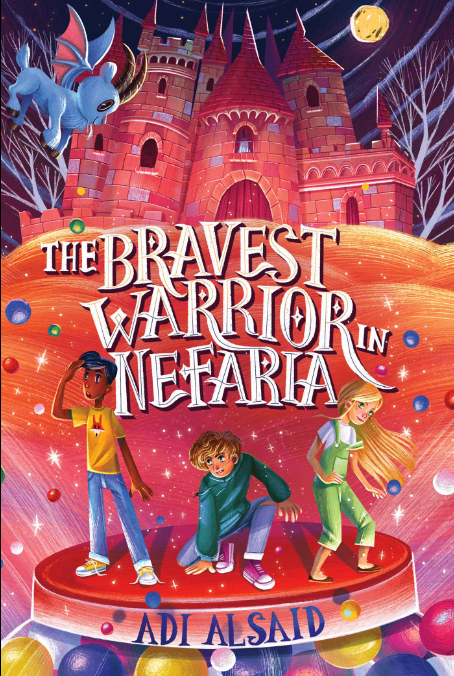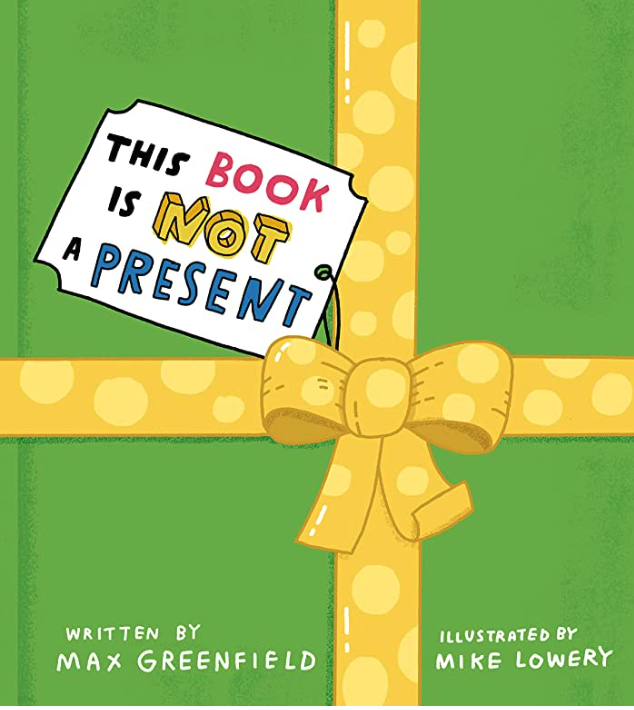I’m sorry to be rude, but I’m just not a fan. As a book of opposites, it’s got too much clutter burying the less-than-clear opposites, but as a story it lacks much in the way of compelling plot or characterization.
Category Archives: Not Recommended
The Bravest Warrior in Nefaria
By Adi Alsaid

Bobert lives in the evil kingdom of Nefaria where everyone does what they can to keep evil “in check”. He lives a life where he feels that he is invisible. He is forgotten by all around him, even his parents. When he follows his classmates to a cursed gumball machine, he is sucked into an evil scheme created by Matt the evil wizard. Will Bobert finally be remembered by his classmates and found before the kingdom is taken over by Matt? Will Nefaria once again become a kingdom that is impervious to these evil schemes?
I found this book to be somewhat difficult to get in to as the storyline seemed difficult to understand at the beginning. The main character, Bobert, was difficult to get behind. If a reader enjoys quirky fantasy with underdog protagonists then they may enjoy this book.
The Story of a Book by Joy McCullough
This vibrantly illustrated book is a love letter to books and reading. It talks about the magic of books, magic that is, “…sweeter when you share it. More powerful when you choose the book yourself.” Beyond those powerful words, it seems to me that the book misses its mark.
Sadly, the book fails to make a distinction between owned books and borrowed books. The early illustrations clearly place the action in a library. Then there is a spread about books being worn out by being chewed on, slept on, spilled on. It depicts the pages of worn books being used for art projects. Because none of these behaviors are appropriate with books borrowed from a library, I do not recommend this book for a school library.
How do Meerkats Order Pizza? : Wild Facts about Animals and the Scientists Who Study Them
Seventeen scientists and their seventeen different research projects are very briefly introduced mixed in with animals cracking jokes all along the way. I should have guessed from the book’s title that this book was not going to be giving mountains of valuable information. Each of the seventeen scientists has an average of ten pages dedicated to them and their work. I wished for more information and less humor.
I did like the diversity of animals being studied and their diverse locations throughout the world. I liked the listing of equipment being used, for example: sunglasses, waterproof notebook and pencil, and waders. I enjoyed the mentioning of the scientists’ early interests as a child.
The is no Table of Contents, no Index, no numbered pages. There is a 17 word Glossary.
Submitted for Annette McQueen by Mary Pong.
This Book is NOT a Present
Written by Max Greenfield, Illustrated by Mike Lowery

This big print, humorous book focuses on how kids would not want a book as a gift for any holiday. It caters to the child who is always on the go and not wanting to sit at any time, let alone to read a book. As I read, I kept waiting for the twist at the end saying something to the effect of “huh, I guess I did enjoy reading a book and getting a book as a gift” but alas that never occured. I had mixed feelings about this book being in an elementary library and thus, I searched for other reviews online. There were many 5 star reviews that seemed to be from parents. Theses parents found this book to be hilarious and their children would want them to read it over and over again. After much thought and consideration, I would not recommend this purchase for a school library where funding is limited as it could discourage reading although it seems to be a hit for a bedtime story.
Penguin’s Party Problems
I just didn’t really like it. I thought the illustrations were busy and text heavy, and the story was a bit dull. Papa Penguin is trying to throw a birthday party for Baby Penguin, and he enlists a lot of different animals to help, and he’s in charge of the food, but after buying fish, thinking everyone will like it, he keeps getting texts from his other guests about their dietary limitations, and instead of waiting until he’s heard from everyone to do his meal planning and shopping, he goes back to the grocery store after every text to buy something to suit the latest request, and then at the end he has to decide what he’s going to make with fish and ants and meat and leaves and durian and vegetables. So he decides to make a cake, with each layer being a different kind. Never mind that the animals who said they only eat leaves or only eat ants probably can’t digest cake. Wouldn’t it have been easier to just set out a buffet? I just don’t think small children are going to relate to grocery shopping frustration. It seemed long for little entertainment.
Alice Nizzy Nazzy
It’s a reprint of a 1995 book. It’s a reinvention of a Russian folk tale set in a Santa Fe context. Maybe I would feel differently if I was more familiar with either the original tale or the current setting, but to me it felt a bit clunky. I’m not sure how much appeal it will have beyond the Southwest, or Russian communities. It describes a girl looking for lost sheep who encounters a local witch all the children have been warned about, who eventually escapes because the witch likes the taste of naughty children and she’s too sweet. But the resolution doesn’t seem especially connected to the other details of the story.
Ten Fat Sausages by Michelle Robinson

“Ten fat sausages, sizzling in the pan…” begins a fresh take on a familiar nursery rhyme, with every other sausage refusing to go “bang” or “pop” and attempting escape instead. Most are not successful, due to a cat, fan, blender and so forth. But, at the end, two escape – not unscathed.
While the notion of a redo of a nursery rhyme is fun, this particular rendition is rather dark and somewhat unpalatable, so to speak. Illustrations of whirring blenders full of pulverized sausage and sliced or bitten sausages are just…yucky. The accompanying text explains each sausage’s end to the general rhyme of “Ten little monkeys”, but falls short on occasion in its faithfulness to the original rhyming sequence.
There are other “food” picture books out there that might be more fun. Or, buy this one and wait for the reactions when you read it aloud. That might be fun, too.
Flamingo Bingo by Heidi Stemple
It’s Flamingo Bingo night and all the birds gather to play. Rhyming text takes the reader through the initial part of the game. Suspense is implied as different birds hope to get a bingo. The bingo cage spills the bingo balls. In the chaos that follows, one bingo number is called and the Toucan calls bingo.
The story is choppy and hard to follow with an abrupt ending making it less than ideal for emergent readers.
Hooves or Hands by Rosie Haine
Would you rather be a horse or a human? An imaginative look at comparing horses and humans and what it might be like to be a horse told through rhythmic text. The color choices in the illustrations reflect the use of imagination as the horses are pink on some pages. The color palette is also limited to primarily pinks, oranges, and blues.
I imagine children would laugh about the line “Stop wherever you are and have a poo…” and the illustrations that show dots for nipples on the half humans, half horses, but I think I would pass on this book.
